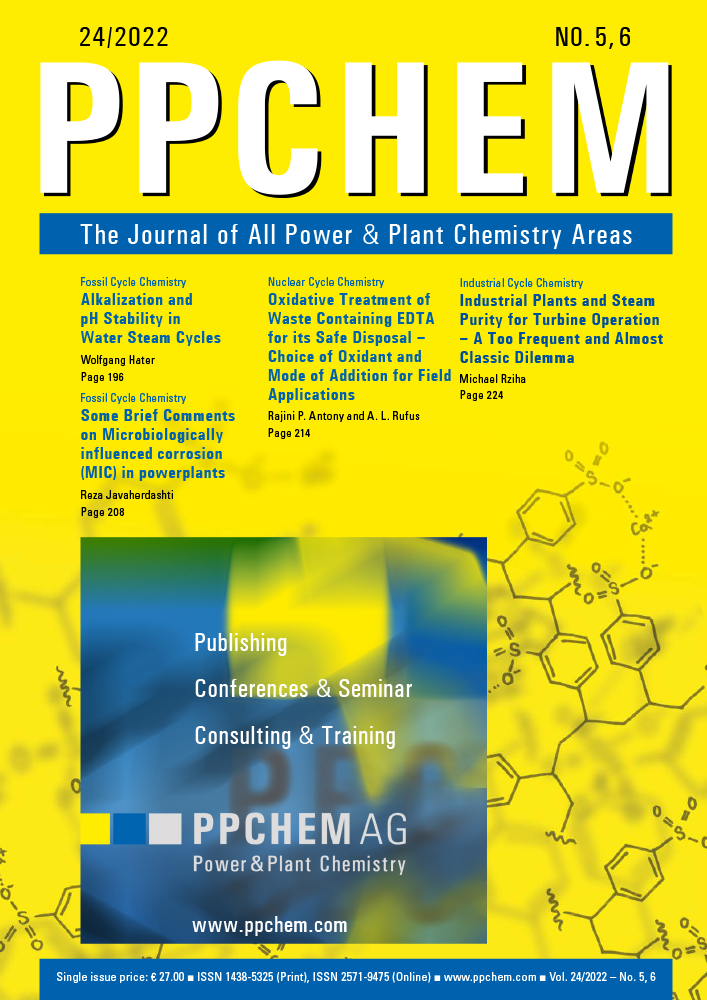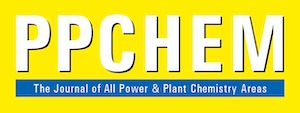
For members only
ABSTRACTS
Alkalisation and pH Stability in Water-Steam Cycles
Wolfgang Hater
The pH adjustment in the water-steam cycle is an important and widely applied measure to maintain plant integrity. The impact of the most common alkalising agents on pH and conductivity is discussed as well as the behaviour of mixtures. A methodology to calculate pH and conductivity from base constant and equivalent conductivity including possible intrusion of acid substances is presented.
With increasing basicity of the alkalising agent, the molar quantities needed to obtain the desired pH value decreases, reaching the minimum value for sodium hydroxide. At the same time, the impact of an ingress of an alkaline or acidic substance increases. Of the alkalising agents discussed in this paper, ammonia shows the highest and sodium hydroxide the lowest stability against pH excursions.
Mixtures of alkalising agents change their properties with regard to pH stability linearly as a function of the composition. Their pH stability reflects the properties of the individual components: a mixture of sodium hydroxide and ammonia has a lower resilience against acid ingress compared to mixtures of trisodium orthophosphate and ammonia.
A high pH stability of the alkalising agent is an important measure to reduce the possible impact of acidic substances entering the system by leakage or decomposition of organic matter. Therefore, this has to be carefully considered when choosing the chemical for alkalisation
PPCHEM® 2022, 24(5,6), 196–206
For Members only
Some Brief Comments on Microbiologically Influenced Corrosion (MIC) in Power Plants
Reza Javaherdashti
This article deals with the most practical aspects of microbially influenced corrosion (MIC) in power plants. The issues discussed here are mainly where to expect MIC in power plants, the inaccurate nature of the term “biofilm” and the possibility of whether bacterial adaptation to biocides can occur. These issues are particularly important from an operation and maintenance point of view because they play an undeniably significant role in reducing the useful service life by increasing the risk of MIC and the cost of its treatment in power plants.
PPCHEM® 2022, 24(5,6), 208–213
For Members only
Oxidative Treatment of Waste Containing EDTA for its Safe Disposal – Choice of Oxidant and Mode of Addition for Field Applications
Rajini P. Antony and A. L. Rufus
High amounts of ethylenediamine tetra acetic acid (EDTA) containing liquid waste along with metal ions (predominantly iron) at pH ~ 8 are generated during the process of chemical cleaning of steam generators in pressurized heavy water reactors and pressurized water reactors. Hence, proper waste disposal involving complete or partial decomposition of EDTA is indispensable. Three different oxidants, viz., air, H2O2, and ozone, were explored for the decomposition of a test solution. Their efficacy was found to be in the order: H2O2 > ozone > air. The lower rate of decomposition in the case of ozone and air is due to their solubility limitations. Investigations on the mode of addition of H2O2 revealed that a bulk/one-time large addition of H2O2 and continuous addition of small quantities at a controlled flow rate yield identical results. On weighing the practical risks/hazards involved in bulk addition during field applications, continuous addition is suggested as a better option.
PPCHEM® 2022, 24(5,6), 214–223
For Members only
Industrial Plants and Steam Purity for Turbine Operation – A Too Frequent and Almost Classic Dilemma
Michael Rziha
Worldwide there are countless industrial installations using steam as a “byproduct” to drive a steam turbine. The steam is generated by many different sources, such as quench boilers and trans-line-exchangers, which are often found in refineries and petrochemical plants. Waste heat boilers in refineries and petrochemical plants can be water tube boilers and shell boilers. Fired flame tube boilers with low or medium pressure (5–50bar) are also used in many installations.
Industrial steam generators often have special requirements regarding load gradients (extremely fast load requirements and/or load reduction). Process steam extraction and process steam condensate return are very common in these plants, and carry the additional risk of the ingress of various contaminants from the different processes, finally leading to a heavy impairment of the steam purity.
Guidelines which are applicable for the feed- and boiler water for the different boiler types and operating pressures are misleadingly taken as “lead documents” although they do not provide the special individual consideration needed for steam purity. It must be emphasized that all such guidelines and standards are only valid for safe boiler operation, and do not address the needs of steam turbines.
In consequence, low-pressure boilers are often operated with softened water. From the perspective of boiler suppliers and boiler operators this might certainly be correct, as the generated steam is used for heating only, where the requirements on steam purity may be more relaxed.
However, and without exception, as soon as the steam is to be used to drive any kind of steam turbine, the relevant standards and guidelines for steam need to be followed. As a matter of principle this will always have an impact on the make-up water, feedwater, and boiler water purity. For example, boilers with a low operating pressure are allowed to be operated with softened or partially demineralized water. This is true and correct for the boiler/steam generator, but it is definitely wrong for any steam turbine tied into this process.
Steam turbine users should be aware of the risks associated with contaminants of the steam, which may initiate, promote, or enhance stress corrosion cracking, corrosion fatigue, general corrosion, erosion, and deposit buildup. Contaminants that are contained in steam generally lead to deposits and corrosion in steam turbines and thus potentially negatively affect their functioning and operational safety, as well as their lifetime. It must also be emphasized that corrosion and/or deposit build-up and consequently damage and/or impairment of performance or availability depend not on the size of the turbine, but only on the impurity level and composition of the steam.
Especially when softened water is used, the concentration of sodium in the water is significantly increased by the softening process! The thermal decomposition of sodium carbonates and sodium bicarbonates (products due to softening) always leads to the formation of caustic soda (NaOH), which strongly increases the risk of alkaline stress corrosion cracking of the turbine material! Consequently, when softened water is used as make-up water, a steam turbine operation is clearly excluded!
PPCHEM® 2022, 24(5,6), 224–229
For Members only
Report on the Power Cycle Instrumentation Seminar (PCIS) Austria 2022 in Linz, Austria
Tapio Werder
For the first time in the history of these events, the Power Cycle Instrumentation Seminar (PCIS) series stopped over in a German-speaking country. The PCIS Austria 2022 in Linz was held under the patronage of PPCHEM AG, and SWAN Analytical Instruments provided financial support.
Since 2012, PPCHEM AG and its precursor organization, Waesseri GmbH, have organized more than 30 conferences and seminars around the world with the mission of expanding the knowledge of cycle chemistry and the understanding of analytical instruments. Over the past 10 years, different formats of events have been developed to fit the different needs and interests within the power plant chemistry community.
This report summarizes the two days of the PCIS Austria 2022
PPCHEM® 2022, 24(5,6), 238–240


